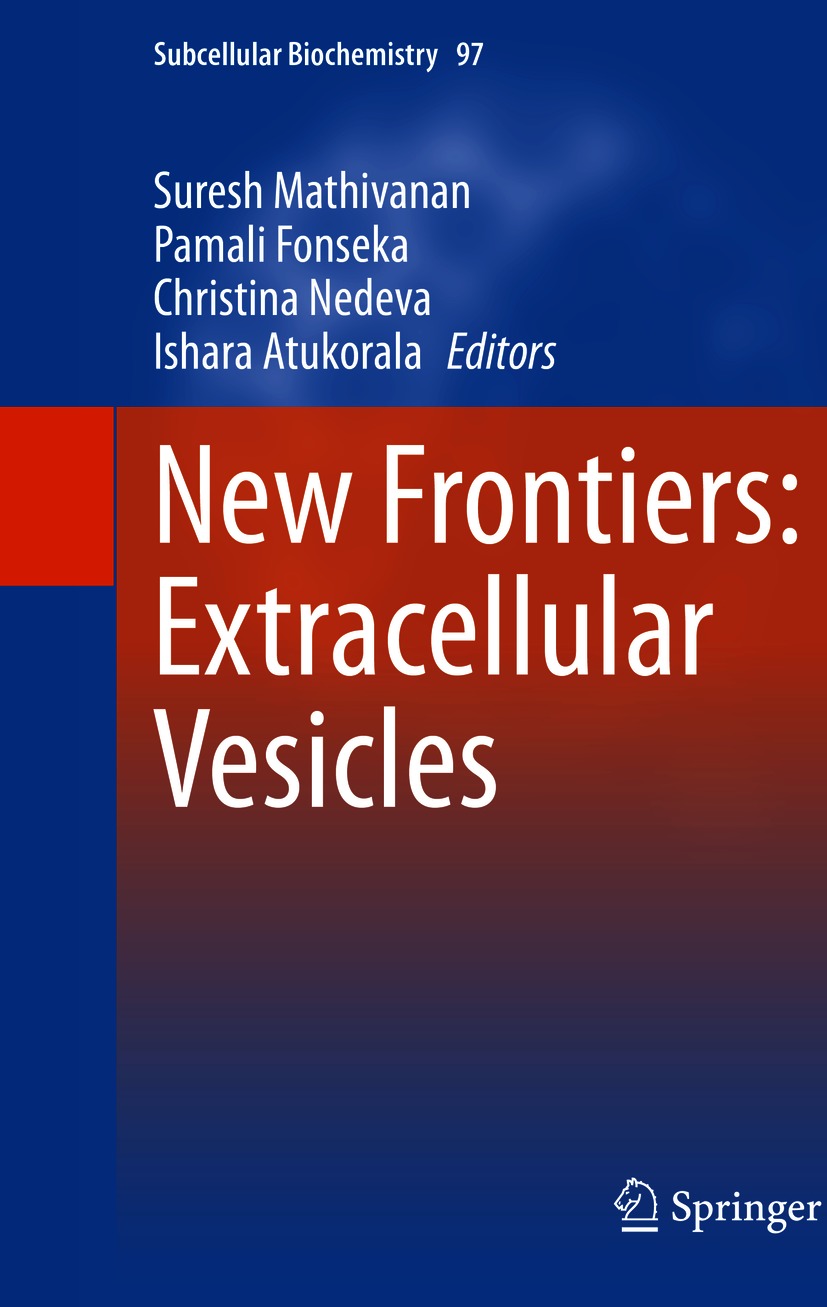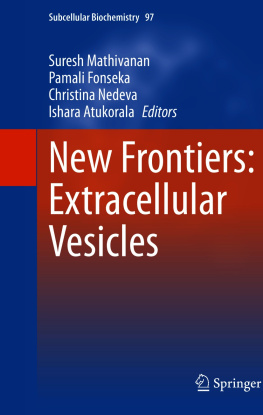Suresh Mathivanan - New Frontiers: Extracellular Vesicles
Here you can read online Suresh Mathivanan - New Frontiers: Extracellular Vesicles full text of the book (entire story) in english for free. Download pdf and epub, get meaning, cover and reviews about this ebook. year: 2021, publisher: Springer International Publishing, genre: Romance novel. Description of the work, (preface) as well as reviews are available. Best literature library LitArk.com created for fans of good reading and offers a wide selection of genres:
Romance novel
Science fiction
Adventure
Detective
Science
History
Home and family
Prose
Art
Politics
Computer
Non-fiction
Religion
Business
Children
Humor
Choose a favorite category and find really read worthwhile books. Enjoy immersion in the world of imagination, feel the emotions of the characters or learn something new for yourself, make an fascinating discovery.
- Book:New Frontiers: Extracellular Vesicles
- Author:
- Publisher:Springer International Publishing
- Genre:
- Year:2021
- Rating:5 / 5
- Favourites:Add to favourites
- Your mark:
- 100
- 1
- 2
- 3
- 4
- 5
New Frontiers: Extracellular Vesicles: summary, description and annotation
We offer to read an annotation, description, summary or preface (depends on what the author of the book "New Frontiers: Extracellular Vesicles" wrote himself). If you haven't found the necessary information about the book — write in the comments, we will try to find it.
New Frontiers: Extracellular Vesicles — read online for free the complete book (whole text) full work
Below is the text of the book, divided by pages. System saving the place of the last page read, allows you to conveniently read the book "New Frontiers: Extracellular Vesicles" online for free, without having to search again every time where you left off. Put a bookmark, and you can go to the page where you finished reading at any time.
Font size:
Interval:
Bookmark:

The book series SUBCELLULAR BIOCHEMISTRY is a renowned and well recognized forum for disseminating advances of emerging topics in Cell Biology and related subjects. All volumes are edited by established scientists and the individual chapters are written by experts on the relevant topic. The individual chapters of each volume are fully citable and indexed in Medline/Pubmed to ensure maximum visibility of the work.
More information about this series at http://www.springer.com/series/6515

This Springer imprint is published by the registered company Springer Nature Switzerland AG.
The registered company address is: Gewerbestrasse 11, 6330 Cham, Switzerland
In multicellular organisms, intercellular communication is critical for the maintenance of homeostasis. The discovery of the pivotal role of extracellular vesicles (EVs) in intercellular communication has ignited significant interest in the exploration of EV-mediated signalling in physiological and pathological conditions. EVs are heterogeneous in nature as they differ in their biogenesis and secretion, cargo content and the cell type of origin. Despite the heterogeneity, their biophysical properties overlap to an extent. The rich cargo content of EVs often reflects the cell of origin and their physiological status. They are stable, membranous nanovesicles that have been shown to participate in many disease conditions. However, the role of EVs in normal physiological conditions is poorly understood. In this book, the fundamental molecular mechanisms involved in EV biogenesis, cargo sorting and secretion will be discussed first. In the second half of the book, the functional role of EVs in various disease settings is highlighted.
EVs can be classified into several subtypes including exosomes, apoptotic bodies, ectosomes or shedding microvesicles, large oncosomes, migrasomes and exomeres. An introduction to various subtypes of EVs is provided in Chaps. discusses the different EV subtypes and the current techniques involved in isolation and characterisation of EVs. It should be noted that, in order to differentiate between the EV subtypes, it is necessary to adhere to guidelines outlined by the International Society of Extracellular Vesicles (ISEV).
Chapter discusses the role of post-translational modifications in the sorting of cargo into EVs. Gaining deeper insight into the pathways involved in biogenesis, cargo sorting and secretion of vesicles can aid in enhanced understanding of EV biology, thereby aiding in EV manipulation for clinical applications.
EVs are secreted from a plethora of cell types and at different stages of the cell cycle. With the recently gained importance of apoptotic bodies in cellular communication and apoptotic cell clearance, apoptotic bodies have attracted significant interest amongst biomedical researchers. Chapter .
EVs released from non-mammalian cell types have often been shown to alter pathology in disease settings. Bacterial vesicles released from both gram-positive and gram-negative bacteria are known to participate in bacterial communication and can be potentially employed for therapeutic purposes. The physical and functional aspects of bacterial EVs are discussed in Chapter gives a brief overview of the impact caused by fungal EVs on the host and elucidates their functional role.
EVs are considered key players in cell-to-cell communication. These vesicles carry a rich cargo content that often mirrors the cell of origin. EVs modulate phenotypic changes in the recipient cells by the delivery of cargo in a non-selective manner. Hence, it is important to understand the various EV-based cargo delivery mechanisms. Chapter .
During the process of cancer progression, vascular changes occur in tumours to aid in metastasis. Chapter discusses the progress that has been made in utilising EVs for the treatment of cancer whilst addressing the hurdles associated with the adaption of EVs as feasible drug delivery systems.
EVs have also been implied in other complex diseases such as metabolic disease (Chap. gives an overview of the current knowledge pertaining to the involvement of EVs in sperm maturation and male fertility.
Font size:
Interval:
Bookmark:
Similar books «New Frontiers: Extracellular Vesicles»
Look at similar books to New Frontiers: Extracellular Vesicles. We have selected literature similar in name and meaning in the hope of providing readers with more options to find new, interesting, not yet read works.
Discussion, reviews of the book New Frontiers: Extracellular Vesicles and just readers' own opinions. Leave your comments, write what you think about the work, its meaning or the main characters. Specify what exactly you liked and what you didn't like, and why you think so.










